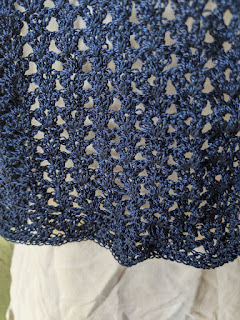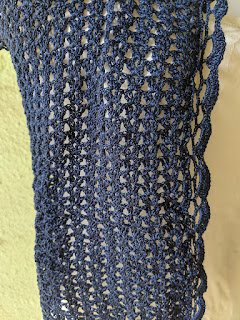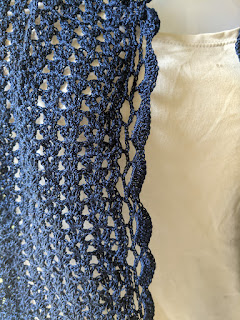This is a really quick & easy 1-row repeat pattern that gives you this beautiful lacy bolero or jacket. You'll be amazed with the ease and speed with which this project builds up - and how light and lacy it looks.
With this pattern there are so many ideas and possibilities.
Remember to read all the way till the end of this blog to get all these ideas. Come along..let’s get this cool top done.
In case you have just joined me, know that you can access all of my earlier creations by checking under ‘categories’ on the right hand side of this blog under “Labels”. Then, for your convenience, follow me here or on Facebook, You Tube, Pinterest, Twitter or Instagram.
Check out all my social media handles at the bottom of this blog
Oh, and may I add that the fastest way to find any of my blogs is via Pinterest.
All my blogs can be printed. Find the printer friendly (green) link on the right hand side of this blog. You can also hit Control P (or Command P for Mac) on your keyboard, and the blog will go directly to the connected printer.
Remember that you only print if absolutely essential. Save paper – Save Our Earth.
Do remember to add my blog URL when you make and show off your creation.
Just copy the link on the search bar above - that's the blog URL.
To purchase this or similar yarn online, click here to buy your yarns online via Amazon. While you will still pay the same, I may get paid by Amazon as well.
This is a free blog - so do pay it forward for me. Cheers.
The stitch count is in multiples of 5 + 1
1 : BACK :
Foundation Single Crochet : fsc : https://youtu.be/mcT85fwh4mA
Row 1 : Start with fsc in multiples of 3 + 1 for half the round waist / bust measurement. Turn.
Note : In case you wish to start with regular chain, please work in multiples of 5 + 2, and then work the first sc in the 2nd chain from hook and work sc all the way down the chain. At the end of your row, ensure that you have multiples of 5 + 1.
Row 2 : dc in the 1st fsc ;
(sk next 3 fsc, Shell st in the next fsc) ;
rep (to) till the last 3 sts,
sk last 3 sts, dc in the last st. Turn.
Row 3 : dc in the 1st dc ;
(Shell st in the ch-1 sp of the next shell st) ;
rep (to) all the way till the last shell st ;
dc in the last dc. Turn.
and that's it.. that's our pattern done for the body of our project.
Work all the way in pattern, till you reach the neckline or armhole (depending on depth of neckline or half armhole measure, whichever measure comes first)
How do I know when to stop pattern for the neckline depth or armhole?
You know the length you want for your jacket, right? So let's assume you want a length of 18" from shoulder.
Check round armhole measurement. Let's assume this is 12", so half this is 6"
This means you will subtract this from the length (18 - 6 = 12") and work 12" till you reach the armhole.
Now, here's where you have to check the depth of neckline. In case your neckline is 7", you will subtract 7 from the length (18 - 7 = 11") and one side (which will be neckline deduction) will stop at 11" , and you will work 1" more to start shaping for the armhole.
With shaping both neckline and armhole, remember to keep the shoulder measurement handy. If the shoulder is say 4.5", then we shape till we get that size for shoulder.
Yes, a bit of calculation needed, but the beauty here is that you can use whatever yarn you need - without being stuck to getting one particular yarn as suggested in a pattern.
Right so back to our pattern - we work a rectangle till you reach either the neckline or armhole decrease point. I am just going to give you ideas for both decreases, but you need to work it when you need it (i.e. at the point that you need to decrease).
Back Neckline shaping :
The neckline shaping idea is the same for back and front.
The only difference is that we work a lower neckline for the front and not as low for the back, generally. That said, you could have a similarly low neck for back and front.
Measure the round neck and divide it in half (one half is the back measurement) OR check the neckline measurement from a top that fits you well.
Generally ladies have a neckline measurement of 4".
So this means that you need to first find the centre of your last row and place a marker there. Then place 2 markers 2" on either side of that centre marker. Remove the centre marker.
You will now work till marker and then back to the other side (armhole) and continue thus till you reach the shoulders.
Double crochet 2-tog : dc 2-tog : [yo, insert hk in st or ch-sp, yo and pull up a lp ; yo and draw through 2 lps] 2 times (3 lps on hk) ;
{yo, draw through 2 lps on hk} 2 times. One dc 2-tog made.
This video tutorial at https://youtu.be/1_oPlUfN5eg shows you how to use the dc 2-tog to decrease.
Sometimes we work the dc 2-tog in the same stitch, to use as a decorative stitch. Visit this video tutorial at https://youtu.be/lLUXOJ1sY9w
What are we doing differently for the split dc 2-tog?
In today's pattern we work a split dc 2-tog. One leg of the dc 2-tog is in the ch-sp of the last Shell st and the 2nd leg of the dc 2-tog is on the last dc.
Decrease row 1 : dc in the 1st dc
Shell st in each Shell st till 3 Shell sts before the marker ;
Split dc 2-tog over the ch-sp of the 3rd last Shell st and the next Shell st. Turn.
Decrease row 2 : Split dc 2-tog over the 1st dc and the ch-sp of the next Shell st ;
Shell st in each Shell st till the last Shell st ;
dc in the last dc
Decrease row 3 : Dc in the 1st dc ;
Shell st in each Shell st till the the last Shell st ;
dc in the last dc. Turn.
Continue without any further decrease till you reach the armhole decrease or the shoulder (depending on your armhole and neckline measurement)
You've completed one side of the back neckline decrease. For the other side, mirror the instructions. Re-attach yarn at the armhole and start again.
For advanced experienced crocheters : If you are fussy about stitches facing the same direction, then you need to re-attach yarn at the 2nd marker, but then you need to reverse instructions accordingly as well.
Back Armhole shaping :
If you want a small sleeve that just flops over the shoulder, then you do not need to decrease for the armhole. We will be adding a small cap sleeve anyway but you can just work all the way to the shoulders without an armhole decrease (just working the neckline decrease for shape) if you want. I'll strongly recommend this as it's not just easy but it works really well.
Decrease row 1 : Sl-st past the 1st shell, and sl-st into the ch-sp of the
2nd Shell st ;
dc in that 2nd Shell st ;
Shell st in each Shell st till the 2nd last Shell st ;
dc in the 2nd last dc. Turn.
(leave last shell unworked)
Double crochet 2-tog : dc 2-tog : [yo, insert hk in st or ch-sp, yo and pull up a lp ; yo and draw through 2 lps] 2 times (3 lps on hk) ;
{yo, draw through 2 lps on hk} 2 times. One dc 2-tog made.
This video tutorial at https://youtu.be/1_oPlUfN5eg shows you how to use the dc 2-tog to decrease.
Sometimes we work the dc 2-tog in the same stitch, to use as a decorative stitch. Visit this video tutorial at https://youtu.be/lLUXOJ1sY9w
What are we doing differently for our dc 2-tog?
In today's pattern we work a split dc 2-tog. One leg of the dc 2-tog is in the ch-sp of the last Shell st and the 2nd leg is on the last dc.
Decrease row 2 : Split dc 2-tog over the 1st dc & the next ch-1 sp of the Shell st ;
Shell st in each Shell st till the 2nd last Shell st ;
Split dc 2-tog over the last ch-sp and the last dc. Turn.
Decrease row 3 : Dc in the 1st st (which is that split dc 2-tog) ;
Shell st in each Shell st till the the last Shell st ;
dc in the last st (which is again that split dc 2-tog). Turn.
Continue without any further decrease till you reach the shoulder
One back complete.Repeat all the back instructions for the front, keeping the back as a template for the armhole decrease till you reach the shoulder
Decrease row 1 : Sl-st past the 1st 2 shells, and sl-st into the ch-sp of the
3rd Shell st ;
dc in that 3rd Shell st ;
Shell st in each Shell st till the last Shell st ;
dc in the last dc. Turn.
Double crochet 2-tog : dc 2-tog : [yo, insert hk in st or ch-sp, yo and pull up a lp ; yo and draw through 2 lps] 2 times (3 lps on hk) ;
{yo, draw through 2 lps on hk} 2 times. One dc 2-tog made.
This video tutorial at https://youtu.be/1_oPlUfN5eg shows you how to use the dc 2-tog to decrease.
Sometimes we work the dc 2-tog in the same stitch, to use as a decorative stitch. Visit this video tutorial at https://youtu.be/lLUXOJ1sY9w
Once again we work a split dc 2-tog.
Decrease row 2 : Dc in the 1st dc ;
dc in the next Shell st ;
Shell st in each Shell st till the 2nd last Shell st ;
Split dc 2-tog over the last ch-sp and the last dc. Turn.
Decrease row 3 : Dc in the 1st st (which is that split dc 2-tog) ;
Shell st in each Shell st till the the last Shell st ;
dc in the last dc. Turn.
Continue without any further decrease till you reach the armhole decrease or the shoulder (depending on your armhole and neckline measurement)
Note : Remember that you will reverse these instructions for the other side / neckline.
The armhole shaping idea is the same as for back - but only one side at a time.
Decrease row 1 : Sl-st past the 1st shell, and sl-st into the ch-sp of the
2nd Shell st ;
dc in that 2nd Shell st ;
Shell st in each Shell st till the last Shell st ;
dc in the last dc. Turn.
Once again we work a split dc 2-tog.
Decrease row 2 : Dc in the 1st dc ;
dc in the next Shell st ;
Shell st in each Shell st till the 2nd last Shell st ;
Split dc 2-tog over the last ch-sp and the last dc. Turn.
Decrease row 3 : Dc in the 1st st (which is that split dc 2-tog) ;
Shell st in each Shell st till the the last Shell st ;
dc in the last dc. Turn.
Continue without any further decrease till you reach the shoulder
Whipstitch to join : https://youtu.be/wZ-9LNzftMA
Invisible join : https://youtu.be/a6XZQ6VzJFM
Single crochet to join : https://youtu.be/6FXoW_47_dI
For advanced crocheters : You can use the Join-as-you-go method to join the shoulders for a seamless finish. I'd start from the armhole end and work to the centre, using ch-3 spaces, and working it between the ch-sps of each shell.
So sc in the 1st st ;
*(ch 3, sc in the next Shell st ch-3 sp of the back portion of project) ;
(ch 3, sc in the next Shell st ch-3 sp of the front portion of project)* ;
rep *to* till the marker or last st ;
sc in the last st.
Fasten off and weave in ends.
Join-as-you-go joining method : https://youtu.be/zN3ECWTYXBk
You will now join sides till armhole.
This is what you do whether you have worked an armhole decrease or not.
In case you have not worked a decrease, calculate half the armhole measurement (which is what you have to do if you were planning on shaping the armhole anyway), and join till that point. Easy enough, right?
Half Double Crochet : Hdc : yo, insert hk into st ; yo (3 lps on hk) ;
yo, draw through all 3 lps. One hdc made.
Check out the video at https://youtu.be/sDiELJdB2DgHow to work a picot stitch : Traditionally for a ch-3 picot, you work (ch 3, sl-st in 3rd ch from hook). For a ch-5 picot, you will do (ch 5, sl-st in 5th ch from hook).
In case the video does not come on, please visit https://youtu.be/8s3zVaBcn4sCrab Stitch or Reverse Single Crochet stitch : https://youtu.be/cG3crwyHPnk
How to work a picot stitch : Traditionally for a ch-3 picot, you work (ch 3, sl-st in 3rd ch from hook). For a ch-5 picot, you will do (ch 5, sl-st in 5th ch from hook).
4) You can work the same pattern that we've worked around the armhole.
For this, remember we're working ch-sps all around, and again working it along the horizontal bars of the dc.
The only difference is that at each corner, we will work a ch-3 sp into the same st (just as we worked 3 sc into the same corner st at each corner for Ideas 1 - 3)
Re attach your yarn at the corner st of the front lapel
Round 1 : Sc in the 1st ; ch 3, sc in the same 1st st ;
If you're visiting me here for the first time, and have liked the experience, do add me to your mailing list (for your convenience) , and all my future free patterns will come straight to your mail box.
It is sad that though my blogs are very popular and being used by so many, not many think of giving credit when you post your projects on social media.
There is a lot of work that goes into writing one of these patterns, so do pay it forward – good karma and all that blah ☺









No comments:
Post a Comment
Thanks for taking the time to stop by. Do tell me what you think. Cheers